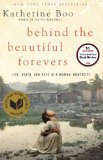Most of us living in the fast-growing Indian cities tend to ignore the slums that dot these cities and the slum-dwellers who live within - just as we tend to ignore the garbage strewn all around us. Katherine Boo with her book “Behind The Beautiful Forevers” manages to make us pause and think about these less-privileged folks who have been dealt a rough hand in life as well as our garbage that provides livelihood to many such folks. It is beautifully-written, especially for a first book, and is a must-read.
The book is based on the lives of some residents of the Annawadi slum near the Mumbai airport, which happens to be surrounded by posh five-star hotels presenting a stark contrast to the abject conditions of its residents. (The slum lay behind a big billboard near the airport advertising bathroom-tiles and proclaiming “BEAUTIFUL FOREVER BEAUTIFUL FOREVER BEAUTIFUL FOREVER”; hence the title of the book.)
There is Abdul, a quiet trader and sorter of garbage brought to him by many of the other residents of the slum, mostly children. There is Asha, ostensibly a teacher and a social-worker, who is determined to improve her lot in life using politics, sex and corruption. Then there is Manju, the college-going idealistic daughter of Asha, who is also determined to improve her lot in life, but through a path of virtue. There are a few “road-boys”, petty teenaged thieves getting high on eraser-fluid used for typewritten-documents, and some rag-pickers, who also feature in this book.
Abdul's life is turned upside down when he is falsely-implicated in the suicide of his one-legged nymphomaniac neighbor Fatima. He faces deplorable brutalities from the corrupt police officers who arrest hime, indifference from the judiciary from whom he seeks justice and a complete loss of livelihood. His family loses all its savings and their house. All their efforts this far to improve their condition in life comes to a naught in the face of this tragedy. The book goes on to tell us how they struggle to put their life back together.
Though the book is based on real people and real events, it reads like a page-turner of a novel. I had assumed that the book is a dramatized account of the original story to make it more appealing to readers, but reading the very interesting “Author's Note” section at the end of the book revealed how hard the author worked to piece together the events and the thoughts of the featured characters using disparate, often contradictory, accounts of numerous individuals (at least 168 people). This is a very well-researched book put together by a very patient and doggedly-persevering author and still the writing is far, far from stilted.
Going by the praise for the book upon its release and several notable mentions in the mainstream media, I was quite skeptical when I began reading the book, wondering whether the hype was justified or whether it was the outcome of very effective public-relations. I am happy to report that I was wrong - the public-relations efforts of the publisher notwithstanding, all the accolades heaped upon this book and its author are well-deserved.
